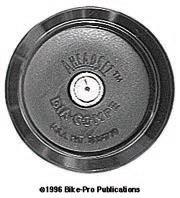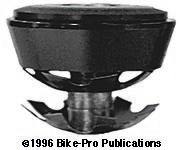Brake Systems
- Brake/Shift Levers
- Caliper Brakes (Road)
- Cantilever Brakes (MTB)
- Brake Levers
- Brake Shifter Combination Levers
- Brake Boosters
- Brake Cables
- Brake Carriers
- Brake Hangers
- Brake Pads
- Titanium Brake Hardware
Computers
Cranks and Chainrings
Forks
Frames & Framesets
Freewheels and Cassettes
Front Derailleurs
Grips
Handlebars
Handlebar Extensions
Headsets
Helmets
Hubs and Skewers
Lubricants
Metal Guide - Bicycle Metallurgy
Mirrors
Pedals and Toe Clips
Pumps and Inflation Systems
Racks
Rear Derailleurs
Rims & Rimstrips
Saddles
Seatposts and Binder Bolts
SRP Replacement Titanium &
Aluminum parts - Master Index
Stems
Tires
Tubes
Shoes
Spokes (Tables Only)
Tools - Bicycle Repair Tools
Yakima Fit List -to fit all cars
Notes
Links
Home
Overview of Aheadsets


DIA COMPE AHEAD PROJECT
Dia Compe has innovated the headset, stem and fork connection with the creation of their Aheadset project. Traditionally, the way the fork, stem and headset have worked together, added unnecessary weight, and weakened the fork steerer tube. The weight was gained in the stem, because it requires the stem quill tube, the stem expander bolt, and the expander wedge, all to fasten the stem inside the fork steerer, to integrate the steering. The fork steerer tube was weakened when the threads were cut, because the cut grooves made the tubing wall thinner, and created a natural fracture point for the steerer to snap off at, once the fork fatigued through use. Another way to fasten the stem to the steerer would be to have it cinch, using a pinch bolt system, to the outside of the steerer, rather than inside the tube. This is the way the stem for the stoker, (rear rider position on a tandem), is fastened to the captain's seatpost on a tandem bicycle. Clamping it to the outside of the steerer also means there are no cut grooves to weaken it, so it can remain the full thickness throughout. The Aheadset project employs these principles. The steerer tube on most forks is now available without threads, the first was the Rock Shox fork. This project required the collaboration of other makers in the industry. Control Tech was one of the first making an Ahead style stem, and the Ahead Stem is addressed in the stem section of this book. Originally, two companies were brought in to address the headset issue, one was Chris King of USA, the other was Hatta of Japan. There are now several factories that make an Aheadset styled headset, including a Taiwan factory that now makes an inexpensive Aheadset model for production of complete bikes made in Taiwan, Dia Compe which has some models made in the USA, and Tioga which has licensed the Aheadset concept and generally has their headsets made by Tange Sekai of Japan. Many makers have been used for the headset because they appeal to several different price points, and address the quality needs of those wanting ball bearing retainers or sealed bearing cartridges. The discussion wouldn't be complete without telling you how the top of the steerer tube is closed off. Dia Compe designed a special expanding nut that they refer as the "Star Fangled Nut" or SFN, (which many machinists will recognize as a square or round metal tubing connector). The nut is incorporated into a cap and plug that has a 5mm bolt passing through them, which draws up a threaded nut with star fashioned arms. When the nut is tightened up, these star arms grip the inside of the steerer and hold the tapered compression plug firmly in place.

